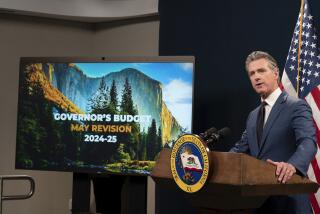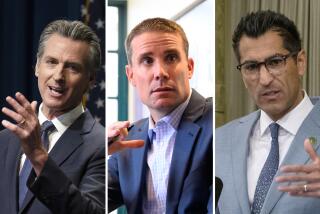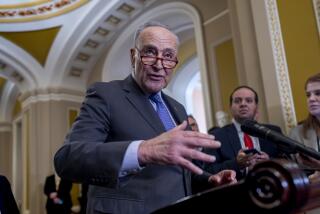Spending Plan Now Clinton’s Top Priority
WASHINGTON — Friday afternoon, as Administration officials studied how to respond to new employment figures showing strong improvement in the economy, President Clinton summoned his top economic aides to a meeting in the White House Roosevelt Room.
The campaign to sell higher taxes and cuts in government spending had gone better than expected, Clinton told them. “But we can’t forget what the campaign was all about,” he said, according to several who were present.
The new spending plans he had proposed--money for expanded Head Start programs, for new investments in high technology, for national service and childhood vaccinations--were “the heart and soul” of what his presidency was about, Clinton said.
With that reminder came a directive: Preserving what Clinton calls his “investment package” has now become the top priority for the Clinton White House.
Monday, Clinton repeated that message in a speech to a sympathetic audience of mayors and to somewhat more skeptical listeners--members of the House Budget Committee who are looking for ways of making further cuts in the federal budget.
Clinton told the members of Congress that he would agree to trim the deficit by an additional $50 billion to $55 billion over the next five years, “but no farther,” senior aides present at the meeting said.
Later Monday, however, influential House Democrats agreed to an additional $63 billion in deficit reduction measures beyond those recommended by the White House.
Administration budget planners believe that they can find ways to accommodate up to $55 billion in additional cuts without jeopardizing Clinton’s program but do not believe that they could go further, officials said.
In a way, Clinton has now become something of a victim of his own success. After weeks of selling budget cuts, the President is now having to persuade the country to also accept budget increases at the same time.
New taxes, which Clinton and his aides thought would be the hardest part of their package to sell, “are basically a done deal,” White House strategist Paul Begala said. “Now we have to sell investment.”
But White House strategists acknowledge that the effort faces two major problems. Because of the overall need to cut the deficit, much of the money for Clinton’s programs will have to come from funds now allocated to existing spending. As members of Congress begin to approach actual votes on Clinton’s package, the zero-sum equation is causing problems.
“We’re hearing people say, ‘Well, I like the idea of an extra $100 million for Head Start, but don’t take it out of my program,’ ” one senior Administration official said.
The second problem, Clinton aides concede, is that although the President strongly believes that an activist government can solve problems for average Americans, many average Americans are far more skeptical.
“We have to convince people that not all spending is the same,” the senior official said.
Clinton strategists hope they can handle both of those problems with a public campaign on behalf of the President’s new spending initiatives, which will drive much of the White House schedule for the next several weeks.
White House aides at one time, for example, had discussed sending Clinton to the South this week for a series of speeches designed to persuade conservative voters that his package was a serious attempt to cut the budget.
Now, that idea has been put off. Instead, Clinton will fly to an aircraft carrier and talk about those parts of his spending programs designed to help military personnel and defense workers caught up in the cutbacks of the nation’s defense spending.
Next week, aides plan an event to highlight Clinton’s proposal to help cities in hiring 100,000 new police officers.
“We have to elevate the specifics,” the senior official said. “If people see you’ve just got a big package out there, they’ll want to cut it. If they look into the package and see money for 100,000 cops or $2 billion in worker training, or $3 billion for Head Start, we think they’ll support those things.”
The need to protect Clinton’s new spending programs was the major thrust of Clinton’s radio address Saturday and of his speech Monday to the mayors, where he lightly ridiculed opponents of his spending plans as defenders of “status-quo-lite.”
The argument from his opponents is “ ‘Yeah, I know you’ve got to change on the cutting side and maybe we have to have a little tax increase, but there is no distinction between kinds of government spending’ ” so nothing new should be spent, he said.
Clinton also presented a two-pronged argument that aides say foreshadows the speeches he is likely to make over the weeks ahead.
First, Clinton and his aides will try to combat the sense that the economy has already begun recovering enough that his proposed $30-billion short-term stimulus plan is no longer needed.
“There are jobs still begging to be created out there,” Clinton told the mayors.
Top Administration officials plan to push the same line.
The second major part of Clinton’s argument will be that beyond short-term stimulus, the economy will grow better in the long term if the government spends more on education, worker retraining, infrastructure improvements and new technologies.
More to Read
Get the L.A. Times Politics newsletter
Deeply reported insights into legislation, politics and policy from Sacramento, Washington and beyond. In your inbox three times per week.
You may occasionally receive promotional content from the Los Angeles Times.











